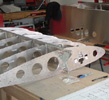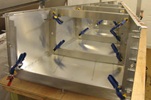


random user submitted photo
Stall Tests
6 posts
• Page 1 of 1
Stall Tests
So while the wings were tufted for testing VG's - Flew some stalls on Friday. Managed to get a left and right camera ALMOST in synch for most stalls.
Graeme JW Smith
-

GraemeSmith - Posts: 939
- Joined: Sat May 18, 2019 8:58 am
- Location: RI
Re: Stall Tests
Hi Graeme (almost couldn’t resist adding “cracker”, fortunately I’ve matured beyond that stage in life).
1. What are you tufting with, tuft material and tape type.
2. Have you confirmed that you have full up elevator authority as per the plans?
3. Are you highly confident in your current t weight and balance information?0
Love the testing and the documentation. Look forward to further pushing out on the envelope.
Cheers, Gordon
1. What are you tufting with, tuft material and tape type.
2. Have you confirmed that you have full up elevator authority as per the plans?
3. Are you highly confident in your current t weight and balance information?0
Love the testing and the documentation. Look forward to further pushing out on the envelope.
Cheers, Gordon
Waiex 158 New York. N88YX registered.
3.0 Liter Corvair built, run, and installed.
Garmin panel, Shorai LiFePo batteries.
3.0 Liter Corvair built, run, and installed.
Garmin panel, Shorai LiFePo batteries.
- GordonTurner
- Posts: 668
- Joined: Tue Feb 21, 2012 1:14 am
- Location: NY, NY
Re: Stall Tests
GordonTurner wrote:1. What are you tufting with, tuft material and tape type.
A fine acrylic yarn and thin duct tape (I'm going to regret this later when removing). The end of the wool is set in a rivet head and the tape firmly blended on top of it
GordonTurner wrote:2. Have you confirmed that you have full up elevator authority as per the plans?
Yes
GordonTurner wrote:3. Are you highly confident in your current t weight and balance information?0
Reweighed and balanced last Feb at Condition Inspection. So yes.
--
The idea came from some videos my upset and recovery CFI had made. They filmed the heck out of their tufted aircraft to make teaching points about what was going on with airflow that got you into upsets and what control inputs worked (and didn't) to get you back out again. As a visualization tool its useful. For fine measurement - a lot less so.
One thing that is apparent from reading about the VG's (Previous video) in some work by NASA is that VG's cause pressure differences on the wing. For full visualization you need:
- Smoke streams from the wind tunnel
- Flush Pressure sensors set in the wing skin
- Tufts are a poor man's sensor in comparison to the first two.
NASA has some interesting video of fully attached boundary layer smoke streams with quite different lift developed depending on speed of the air (expected)
But they also have fully attached smoke streams with quite different amounts of lift generated with the SAME airspeed but with the addition of VG's.
So tufts are useful but not really telling the whole story. I didn't consider them much more than "coarse" visualization tools as a result. What I have also found them useful for was confirming some of the "feel" I am getting doing acro - confirming some stuff that is just vibrating flaps and other stuff is me pulling too hard and getting accelerated stalls!
Graeme JW Smith
-

GraemeSmith - Posts: 939
- Joined: Sat May 18, 2019 8:58 am
- Location: RI
Re: Stall Tests
Great videos!
Bryan Cotton
Poplar Grove, IL C77
Waiex 191 N191YX
Taildragger, Aerovee, acro ailerons
dual sticks with sport trainer controls
Prebuilt spars and machined angle kit
Year 2 flying and approaching 200 hours December 23
Poplar Grove, IL C77
Waiex 191 N191YX
Taildragger, Aerovee, acro ailerons
dual sticks with sport trainer controls
Prebuilt spars and machined angle kit
Year 2 flying and approaching 200 hours December 23
-

Bryan Cotton - Posts: 5489
- Joined: Mon Jul 01, 2013 9:54 pm
- Location: C77
Re: Stall Tests
VERY VERY good demo, and data collection methods! great job! I am sure we all can gleen info from these videos! thanks much for your efforts here!!
Joe Nelsen
scratch built :D
Sirpeedee, N502PD, s/n 1510, Aero Vee 2.1 s/n 0870,
ADS-B in (Stratux)/out(SkyBeacon)
Flying @81.7
KGYI/N. Tx Reg/Perrin Field
EAA Technical Counselor, Chapter 323, Sherman, TX
scratch built :D
Sirpeedee, N502PD, s/n 1510, Aero Vee 2.1 s/n 0870,
ADS-B in (Stratux)/out(SkyBeacon)
Flying @81.7
KGYI/N. Tx Reg/Perrin Field
EAA Technical Counselor, Chapter 323, Sherman, TX
-

n502pd - Posts: 380
- Joined: Sat Feb 23, 2013 12:13 am
- Location: Gunter, Texas
Re: Stall Tests
If you want to keep the spin going indefinitely, you don't need any aileron. Just keep the ailerons neutral, hold the stick full back and hold the rudder pedal. With an AeroVee (VW) you want to hold down the left rudder pedal. The AeroVee doesn't spin very well to the right; it mushes to the right.
I could have kept this left spin going forever, but stopped after 5 turns. I probably had 8 gallons in the tank, and me. Nothing else. So no rear CG.
https://www.youtube.com/watch?v=gPzQ3Ruq8LY
Same here, at 3:55. I had 10 gallons in the tank this day.
https://www.youtube.com/watch?v=1nD_tDJMEsE
I could have kept this left spin going forever, but stopped after 5 turns. I probably had 8 gallons in the tank, and me. Nothing else. So no rear CG.
https://www.youtube.com/watch?v=gPzQ3Ruq8LY
Same here, at 3:55. I had 10 gallons in the tank this day.
https://www.youtube.com/watch?v=1nD_tDJMEsE
Mike Smith
Sonex N439M
Scratch built, AeroVee, Dual stick, Tail dragger
http://www.mykitlog.com/mikesmith
Sonex N439M
Scratch built, AeroVee, Dual stick, Tail dragger
http://www.mykitlog.com/mikesmith
- mike.smith
- Posts: 1430
- Joined: Tue Jan 29, 2013 8:45 pm
6 posts
• Page 1 of 1
Who is online
Users browsing this forum: No registered users and 65 guests







